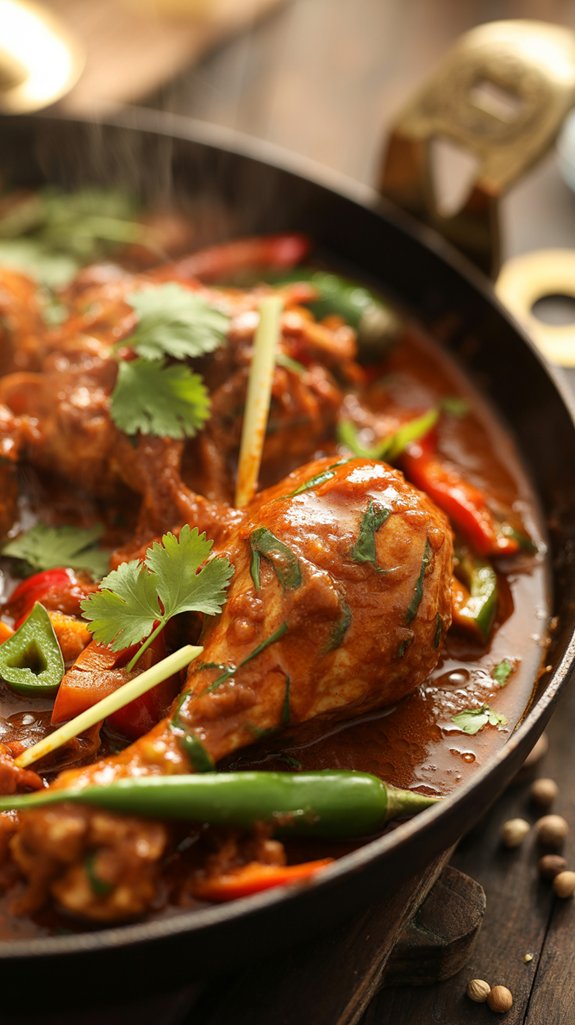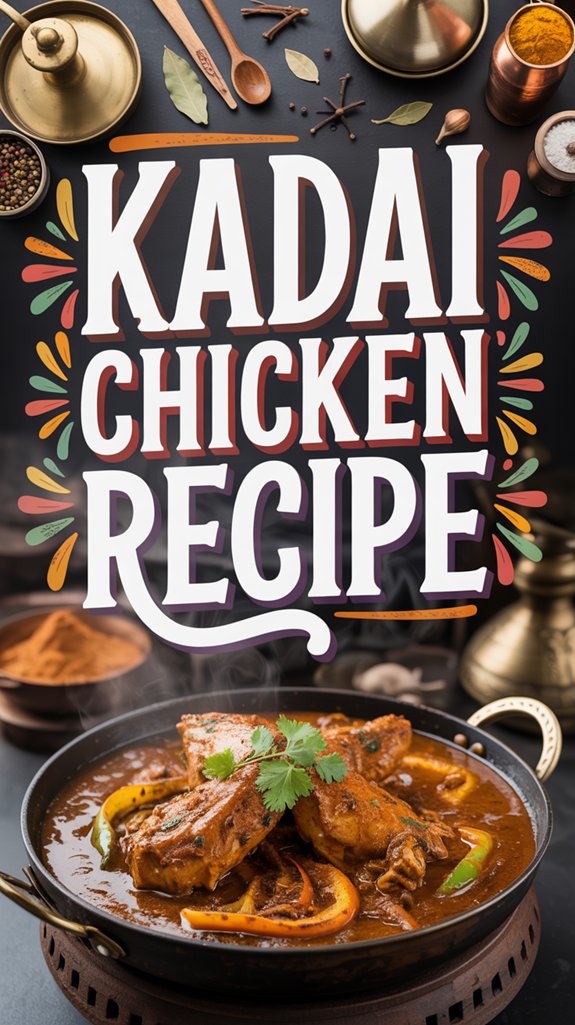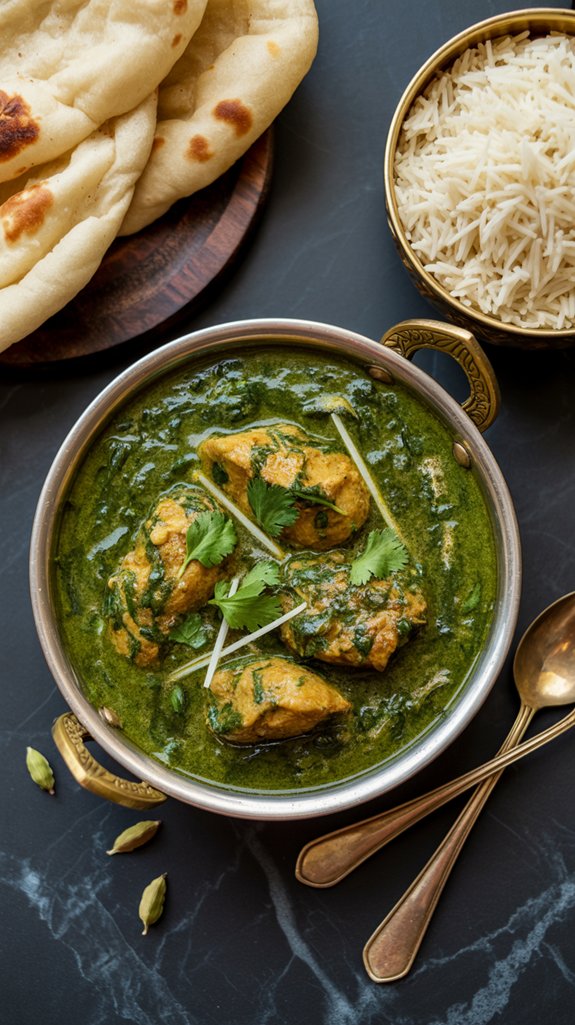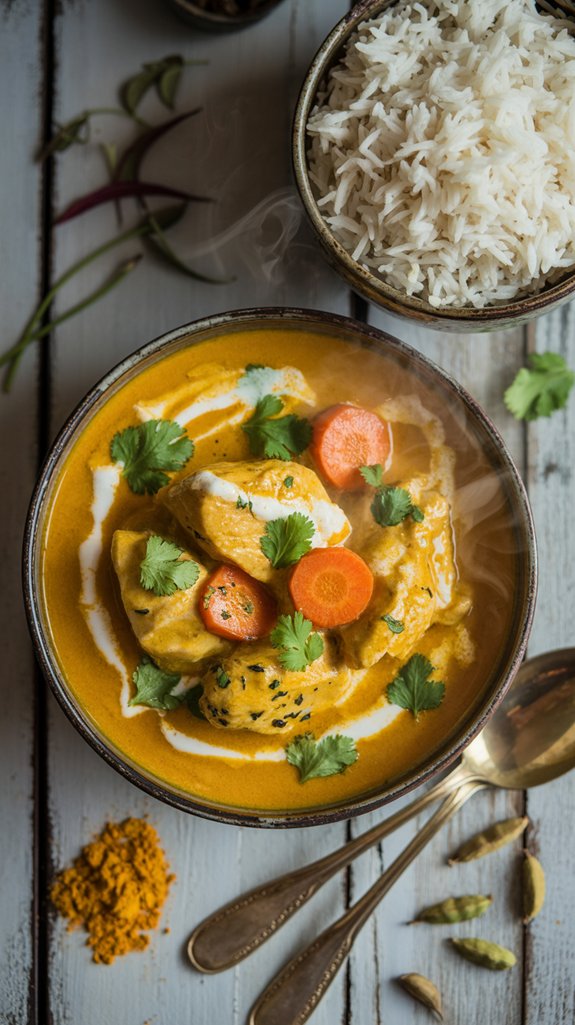Why You’ll Love This this Sizzling Indian Kadai Chicken
This recipe transforms humble chicken pieces into a restaurant-worthy masterpiece that’ll have your kitchen smelling like the best Indian takeout joint in town.
The beauty lies in how the tomatoes break down into a rich, thick gravy while the capsicums add just the right amount of crunch and color—because let’s face it, we eat with our eyes first.
What really gets me excited is how forgiving this dish is; even if you’re still figuring out the difference between sautéing and frying, the long simmer time gives you plenty of room to course-correct along the way.
Ingredients List
Getting all your ingredients prepped and measured out before you start cooking—what the fancy chefs call mise en place—will save you from that panicked moment when your onions are burning while you’re frantically searching for the garam masala.
- 1 kg chicken
- 50 g ghee
- 25-35 g ginger-garlic paste
- 8 whole red chilies
- 5 g coriander powder
- 2 onions
- 4 green chilies
- 20 g coriander leaves
- 10 g garam masala
- 1 kg tomatoes
- 3 red capsicums
- Ghee vs. oil swap: You can absolutely use regular cooking oil instead of ghee if you’re watching saturated fat intake, though you’ll miss out on that rich, nutty flavor that makes Indian food so irresistible
- Tomato power: With a full kilogram of tomatoes, you’re getting a serious dose of lycopene and vitamin C, which basically means this comfort food has some legit nutritional street cred
- Spice benefits: Those red chilies aren’t just there to make you sweat—they contain capsaicin, which can boost metabolism and has anti-inflammatory properties
- Fresh herb bonus: The coriander leaves add more than just color; they’re packed with antioxidants and can help with digestion after all that rich, delicious food
- Prep the chicken: Skin the chicken and cut into 8 even pieces for consistent cooking.
- Chop vegetables: Dice the tomatoes, green chilies, coriander leaves, onions, and red capsicums into uniform pieces.
- Heat the base: Warm ghee in your wok or heavy-bottomed pan over medium heat.
- Build the aromatics: Add whole red chilies first, then onions, sautéing until they turn light brown.
- Add paste and spices: Stir in ginger-garlic paste for one minute, then add coriander powder.
- Create the tomato base: Add chopped tomatoes and fry until they break down, then add green chilies.
- Develop flavors: Let the mixture simmer for 5-6 minutes until the oil starts separating.
- Cook the protein: Add chicken pieces and capsicum, cooking until the fat floats on top and the gravy thickens.
- Final seasoning: Sprinkle garam masala and add fresh coriander leaves, stirring to combine.
- Taste and adjust: Check for salt and seasoning, adjusting as needed.
- Serve with style: Transfer to serving wok and garnish with chopped coriander leaves and tomato slices.
- Basmati rice – The classic choice, and honestly, is there anything better than fluffy rice swimming in that tomato-capsicum sauce? Long-grain white rice works fine too if that’s what you’ve got.
- Naan or roti – Fresh from the oven is ideal, but let’s be real, store-bought warmed in a dry pan gets the job done. Use it to scoop up every last bit of sauce.
- Jeera rice – Cumin-scented rice adds another layer of flavor without competing with the chicken. Just toast some cumin seeds in oil before adding the rice and water.
- Simple cucumber raita – The cool, creamy yogurt sauce cuts through all that rich ghee and spice. Dice some cucumber, mix with plain yogurt, add a pinch of salt and cumin.
- Pickled onions – A handful of quick-pickled red onions adds brightness and crunch. Just slice thin, toss with vinegar and a pinch of sugar, let them sit while you cook.
- Warm chapati – These thin flatbreads are perfect for wrapping bits of chicken and sauce together, though your hands might get a little messy in the process.
- Don’t rush the onions – I know you’re hungry, but letting them get properly golden brown builds the flavor foundation. Pale, sad onions make pale, sad curry.
- Keep that chicken skin-side down first – Yeah, the recipe says to skin it, but if you’re feeling rebellious and keeping some skin on, start it face-down in the hot ghee for better browning.
- Taste your tomatoes before adding them – Some are sweet, some are tart as your great aunt’s personality. If they’re too acidic, a tiny pinch of sugar works wonders.
- The “fat floating” test is real – When you see those little orange pools of ghee shimmering on top, that’s your signal the chicken is properly cooked through. No guessing needed.
- Fresh garam masala changes everything – Store-bought is fine, but if yours has been sitting in the spice cabinet since the last presidential election, maybe grab a new container.
- Don’t skip the resting time – Let it sit off the heat for 5 minutes before serving. The flavors meld together, and you won’t burn your tongue on molten tomato sauce.
- Save some fresh coriander – I always think I’ve enough, then use it all during cooking. Keep a handful back for that final green pop of color and freshness.
- High protein powerhouse – One serving delivers approximately 35-40g of complete protein from the chicken, supporting muscle maintenance and keeping you satisfied longer.
- Vitamin C boost – Fresh tomatoes, capsicums, and green chilies provide over 100% of your daily vitamin C needs, supporting immune function and iron absorption.
- Healthy fats from ghee – Contains fat-soluble vitamins A, D, E, and K, plus butyric acid which supports digestive health.
- Antioxidant-rich spices – Ginger, garlic, coriander, and garam masala blend provide anti-inflammatory compounds and antioxidants.
- Low carb friendly – Only about 12-15g carbs per serving, making it suitable for low-carb and keto diets.
- Iron content – Chicken combined with vitamin C-rich vegetables enhances iron absorption, supporting healthy blood oxygen levels.
- Lycopene from tomatoes – Cooking tomatoes increases bioavailable lycopene, a powerful antioxidant linked to heart health.
- Capsaicin benefits – Red and green chilies contain capsaicin, which may boost metabolism and provide pain-relieving properties.
- Folate source – Fresh coriander leaves contribute folate, essential for cell division and DNA synthesis.
- Approximate per serving – 380-420 calories, 35g protein, 25g fat, 12g carbs (serves 4-6).
Step by Step Directions

Making this restaurant-quality kadai chicken at home requires proper timing and technique to build layers of flavor.
For the most authentic results, consider using Korean cast iron cookware which provides superior heat retention and even cooking distribution for this traditional dish.
Substitutions and Variations
• Make it creamy: Stir in a few tablespoons of heavy cream or coconut milk at the end for restaurant-style richness.
Greek yogurt works too, but add it off the heat to prevent curdling.
• Herb variations: No fresh coriander? Fresh mint leaves are surprisingly good here, or even fresh basil if you’re feeling adventurous.
Dried herbs just won’t give you the same bright finish though.
• One-pot version: Toss in some diced potatoes with the chicken for a heartier meal that stretches further.
Additional Things to Serve With This Dish
This rich, saucy chicken practically begs for something to soak up all that delicious gravy.
Cooking Tips & Tricks (Chef’s Notes)
After making this dish more times than I care to count, I’ve learned a few tricks that make all the difference.
Nutritional Facts
This hearty kadai chicken packs serious nutritional value alongside its bold flavors.
Fun “Did You Know?”
Ever wondered why your kadai chicken tastes so much better than regular curry preparations?
I’ll share some fascinating secrets! The kadai’s wide, shallow shape isn’t just for show—it creates maximum surface area for ingredients to caramelize beautifully. That distinctive smoky flavor comes from high-heat cooking that’s impossible in regular pots.
Here’s something cool: “kadai” literally means “wok” in Hindi, borrowed from Chinese cooking techniques during ancient trade routes.
The red chilies aren’t just for heat—they release essential oils when heated in ghee, creating that signature aroma.
Finally, capsicums were added much later, making this a fusion dish!





